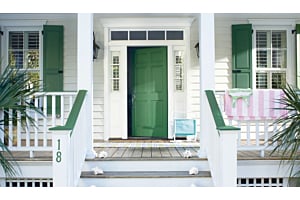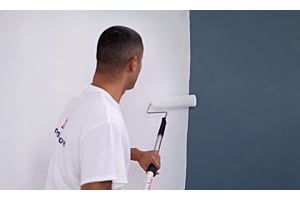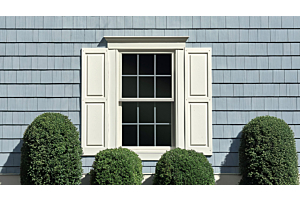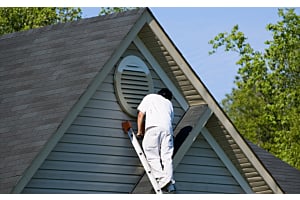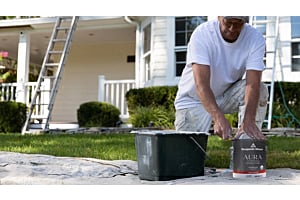
Choosing when to paint is critical to the long-term success of an exterior paint job. If it’s too hot, the paint will dry too fast. If it’s too cold, the paint won’t cure properly. And rain or high humidity might cause the paint to bubble and peel.
So what is the optimal temperature range for painting a house exterior?
Ideal temperatures are between 50° and 80° degrees without extreme temperature changes at night. A perfect day would be overcast (but no chance of rain) and not windy, with humidity between 40% and 70%.
Since life is rarely perfect, read on to learn how to work with the weather to get great results for your next exterior paint project.
Temperature Guides
How cold is too cold for outdoor painting?
“Too cold” generally means below the minimum temperature range stated for your paint. When painting outdoors, the lowest safe temperature isn’t just about when you start painting—the first 24 hours are crucial as the paint begins to cure. (Although the paint might feel dry to touch in 1-2 hours, the first curing cycle lasts about a week.)
Even exterior paints formulated for lower temps require surface temperatures at or above 35°F for 24 hours. (Read more about surface temperature below.) If it gets colder than that, the paint may not dry properly, leading to adhesion issues, cracking, or premature failure.
Water-based acrylic latex paints generally dry faster than oil-based paints. Carefully read the paint specs because dry times are often longer the colder the temps.
If you're working in colder temperatures, Benjamin Moore’s Element Guard is specially formulated to perform with surface temperatures as low as 35°F, making it an excellent option for extending your painting season. Plus, it resists rain after just 60 minutes of drying time. Whether you're tackling a project in early spring or late fall, Element Guard helps ensure a smooth, long-lasting finish—even when the weather isn’t ideal.
For comparison, Sherwin-Williams Duration has a dry time to recoat of 4 hours above 45°, but a dry time of 24-48 hours at temperatures between 35° and 40°.
What happens to the paint when it’s too cold?
Painting when it's too cold outside can lead to frustrating issues that affect both the application process and the durability of your paint job.
Poor Adhesion: Cold temperatures slow down the curing process, preventing the paint from properly bonding to the surface. Peeling is a common consequence of painting in weather that’s too cold–the paint might initially stick, but then detach as it was never properly adhered. The paint will often blister or bubble, and then it peels after the surface goes through a few warm-up cycles.
Uneven Drying: When it’s too cold, paint takes longer to dry, sometimes forming an uneven or blotchy finish. You might see streaks, patches, or areas that appear shinier than others.
Increased Moisture Issues: Cold air often means higher humidity or even frost forming on surfaces overnight. This moisture can get trapped under the paint, causing bubbling, cracking, or even mildew growth over time.
Thick, Difficult Application: Many paints become thicker and harder to work with in cold weather, making it tough to spread evenly. This can result in visible brush marks, roller lines, or an inconsistent texture. Also, the heavier application may result in reduced coverage per gallon.
More Debris in the Paint: Because the paint takes longer to dry, there is an increased risk of insects and debris getting trapped on the surface of the paint.
To avoid these issues, always check the manufacturer’s recommended temperature range and plan your project accordingly.
Planning Your Workday When It’s Chilly
When house painting during chilly weather, you’ll need to keep an eye on that thermometer, and you may need to wait until midday when it’s warmest. Surfaces can be colder than the air, especially in the morning.
Wait until any frost has melted and the surface has dried. Use a moisture meter to test the surface; we recommend a moisture reading below 15%.
It’s also wise to store your paint cans in a warm place overnight and only bring them out when you’re ready to use them – paint that’s been sitting in a cold garage will be too cold even if the air outside has warmed up.
Besides the daytime temperature, consider the overnight lows. If you paint in the late afternoon when it’s 45°F but the temperature plummets to 28°F a couple hours after sundown, that’s trouble. All paint needs drying time before it can withstand a freeze or moisture. Typically, you want at least 4 hours before the dew falls and 24 hours of curing time before the temperature drops below the paint’s minimum.
It’s better to pause the project and wait for a warmer day than to risk a failed paint job in low temperatures. If you live in an area with long winters, take advantage of the newer paints that allow 35°F application, but still try to choose a minimum timeframe of 24 hours above freezing and with a warming trend, not a cold snap.
When is it too hot to paint outside?
At the opposite end of the spectrum, high temperatures can be just as problematic. A common rule of thumb: if the surface is so hot that you can’t comfortably keep your hand on it, it’s probably too hot to paint—often corresponding to air temperatures in the 90s or above.
Direct sunlight in hot weather is especially challenging. Not only is the ambient temperature high, but UV light and the hot substrate can push the paint to dry almost as soon as it’s applied.
What happens to the paint when it’s too hot?
Most paints have an upper recommended limit around 90°F to 100°F. Painting at or above those temperatures, especially in direct sun, will lead to a host of issues because the paint dries too quickly.
Adhesion Problems: Binding problems can occur if the top layer of the paint dries before the underneath has adhered. Drying before film formation is complete can result in a compromise of long-term durability–and the need to repaint sooner.
Lap Marks, Brush Marks, or Uneven Flow: When paint dries (or “skins over”) too quickly, it doesn’t level out nicely. You might see brush marks and an uneven finish because the paint film started to set too soon.
Wrinkling or Blistering: The surface of the paint forms a skin, but as the layer beneath outgases, it creates bubbles or wrinkles since it’s trapped by the top film. Those blisters may peel later on. In severe cases, you can get instant blisters as solvents in the paint boil out.
Planning Your Workday When It’s Just Plain Hot
Still need to get the job done even though it’s mid summer? Here are some tips for painting in the heat.
A simple but effective tip: follow the shade. Many pro painters begin painting on the shady side of a house and work around the home, staying in the shade throughout the day to avoid direct sun.
Try to work in the cooler hours of the day during summer. Early morning (after any dew dries) and late afternoon can be workable windows if daytime highs are in the 90s. if it’s above 85–90°F, focus on prep work instead of painting, or paint small sections at a time with breaks.
Keep the paint itself as cool as possible – don’t leave your buckets sitting in the sun. Pay attention to your paint cans/buckets, roller pan, etc that they don’t skim over with a dry film because it creates application problems. Some pros will mist the surface with a little water (for masonry painting) or add a paint conditioner/extender to slow the drying in hot conditions, but those are advanced techniques. Generally, avoid extreme heat if you can.
Air Temperature vs Surface Temperature
Paint experts know that checking both air and surface temperatures is essential for a successful paint job because these two temps can be quite different—especially depending on the season.
Air Temperature refers to the ambient temperature around you, which is what weather forecasts report. This is an important factor, but it doesn’t tell the whole story when it comes to painting conditions.
Surface Temperature, on the other hand, is the actual temperature of the material you’re painting—whether it’s wood, brick, metal, or siding. Surfaces can retain heat or cold longer than the surrounding air, creating potential problems if you don’t account for them.
In winter and early spring, even if the air temperature rises to an acceptable level for painting, surfaces that have been cold for months may still be below the minimum surface temperature. There also may be retained moisture within the surface that will prevent proper adhesion. It may take several hours of warm sunshine before surfaces reach a safe painting temperature.
In summer, the opposite problem can occur. Dark-colored surfaces, asphalt siding, and metal can absorb and hold heat, making their surface temperature significantly hotter than the air. If the surface is too hot, paint can dry too quickly, leading to brush marks, poor adhesion, and even blistering.
To ensure the best results, always check both the air and surface temperatures before painting. Many pros use an infrared thermometer and moisture meter (we recommend less than 15% moisture content) to avoid issues that could impact the longevity of the paint job.
Humidity & Rain
What is the acceptable humidity range?
Humidity measures the amount of moisture in the air, and it can have a significant effect on paint drying and curing. Ideally, you want to paint when the humidity is between 40% to 70% to ensure that the paint dries properly. Note that this is also true for interior painting. Allow ample time for the paint to dry before sunset to avoid dew on the wet paint.
High humidity slows down the drying process because the air is already saturated with moisture and can’t readily absorb the water or solvents evaporating from the paint.
Low humidity can cause the paint to dry too quickly, leading to many of the same problems that high temps cause.
Another key measure here is the dew point. The dew point is the temperature at which the air is so saturated that water will condense (dew) on surfaces. A good practice is to paint only when the surface temperature is at least 5°F above the dew point.
What happens when painting in high humidity?
Prolonged Drying Time: With high humidity levels, you might find that the paint stays wet for an extended period or even drips or sags before it can dry, especially on vertical surfaces.
Streaking or Discoloration: Dew on fresh paint can lead to issues like streaking or discoloration. For instance, you might see shiny, oily-looking streaks on a new paint job after a dewy night – this is often surfactant leaching, where ingredients in the latex paint are drawn out by water before the paint can fully cure.
Poor Adhesion: Since high humidity slows down the curing process, it can prevent the paint from properly bonding to the surface. When painting wood surfaces, consider the excess moisture that wood absorbs from the air. In some cases, the moisture might hinder paint adhesion or cause bubbling and peeling.
How long should I wait to paint after it rains?
You generally want to wait at least 24 hours after rain before painting exterior surfaces. The surface needs to be thoroughly dry. If the weather is cool and cloudy, give it 48 hours if possible. This is especially true for porous materials like wood and masonry.
Wood siding that got soaked in a rainstorm might look dry a few hours after the sun comes out, but there could still be significant moisture within the wood fibers. Painting over that can trap moisture, leading to blistering or peeling later.
Concrete, stucco, and brick also hold water. They may even show dark damp spots for a while. Make sure those are gone. Likewise, after power-washing a house, wait a day or two before painting, since power washing saturates the siding.
A moisture meter can tell you if the substrate is dry enough (usually wood should be under about 15% moisture content to paint). If you don’t have one, err on the side of caution.
How long does my paint need to dry before it rains?
In an ideal world, plan your project so that no rain is expected for 24 hours after painting. If you use a standard exterior latex paint, many labels say it needs to dry for at least 4 hours (at ~77°F, 50% humidity) before it can withstand rain.
If a heavy downpour hits a not-fully-cured paint job, you risk wash-off or spotting. So check the forecast and choose a paint day with a good window of dry weather afterward.
Rain resistant paint can be a game-changer if you’re in a climate where surprise showers are frequent. Benjamin Moore’s Element Guard can resist rain about 60 minutes after application and is formulated to provide excellent adhesion and resistance to cracking and peeling, withstanding wind-driven rain, humidity, and other harsh weather. Think of it as insurance for an unpredictable shower rather than an excuse to paint right before a storm.
Get Expert Help at Ring’s End
Our advice to both professional painters and DIY homeowners is to pay attention to the paint manufacturer data sheet regarding recommended temperature and drying times—and don’t cheat those recommendations. If you’re in doubt, it’s safer to wait an extra day than to paint in marginal weather conditions that could ruin your hard work.
Our paint pros are here to help––Talk to a real person using our online chat or by texting (203)-PRO HELP. Happy painting, and may the forecast be in your favor!

